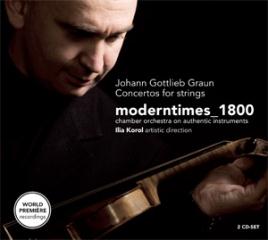Johann Gottlieb Graun – Concertos for Strings (2009)
Johann Gottlieb Graun – Concertos for Strings (2009)

Johann Gottlieb Graun, Concerto c minor 01. Allegro 02. Largo 03. Allegro Johann Gottlieb Graun, Concerto G major 01. Allegro 02. Adagio 03. Allegro molto e con spirito probably Markus Heinrich Grauel, Concerto A major 01. Allegretto 02. Adagio 03. Allegro Johann Gottlieb Graun, Concerto F major 01. Allegro 02. Mesto 03. Allegro Johann Gottlieb Graun, Concerto E flat major 01. Allegretto 02. Adagio, un poco Andante 03. Allegro Ilia Korol - violin, viola solo, artistic director Piroska Batori - violin solo moderntimes_1800 (ensemble)
Johann Gottlieb Graun was born in 1701 or 1702 in Wahrenbrück. He studied for several months between 1721 and 1723 with Giuseppe Tartini (1692-1770) in Padua. Tartini had a lasting impression on the young Graun; this can also be heard in his compositions. In 1740 Graun was nominated as concertmaster and conductor at the court-orchestra of Frederick II of Prussia. Graun’s duties included having to scout for new talent for the orchestra, and the direction of the court concerts in Berlin. After the Seven Years’ War, Graun retired from active duty for reasons of health. He died, highly esteemed, on 7 October 1771 in Berlin. Instrumental works utterly dominate the extensive oeuvre of Johann Gottlieb Graun as a composer. It is hardly surprising that among them – besides overtures, symphonies, quartets, trios and wind concertos – he wrote a great number of concertos and solo Sonatas for the violin. He composed at least 83 solo concertos, double concertos and several ensemble concertos with solo violin. (A sinfonia for 8 winds & b.c., also performed by moderntimes_1800, is to be found on CC72193) The concerto by Markus Heinrich Grauel on this CD may be taken as an example of Graun’s influence. ---ensemble-moderntimes.com
The concertos on these two discs show that he gradually moved away from counterpoint. The Concerto in c minor is the earliest piece in this set and was written in 1730 or even earlier. Particularly beautiful is the largo in which the violin moves over a tutti which is dominated by a motif of three notes. Although the scoring includes two oboes they have no independent parts but play colla parte with the violins.
That is also the case in the Concerto for two violins in G. The scoring includes two parts for horns, and these are independent and play a noticeable role in the fast movements, but are silent in the adagio. This movement is dominated by Seufzer and descending figures, both in the solo parts and in the tutti.
Graun's acquaintance with Giuseppe Tartini has had a strong influence on his compositional style. The Italian master didn't avoid virtuosity, but gave priority to expression. That is also the main feature of Graun's concertos, and it is no coincidence that in two concertos the slow movements are the longest. In the Concerto in F the second movement, mesto, is almost twice as long as the fast movements. That is different in the Concerto for viola in E flat. It is one of only two concertos for this instrument which are known from Graun. It is a particularly beautiful work, with a magnificent cantabile solo part in the middle movement, with the character indication 'adagio, un poco andante'.
The only piece which is not by Graun is the Concerto in A, which is attributed to Markus Heinrich Grauel. He is an almost completely unknown quantity, and has no entry in New Grove. The concerto is to be found in the archive of the Berlin Singakademie, and it says 'del Sigr. Grauel'. The man to which it is attributed was cellist in the court orchestra in Berlin from 1763. Considering his style he is thought to have been a pupil of Graun. It is less virtuosic but quite beautiful. The first movement is dominated by drum basses, a feature of many compositions from the mid-18th century.
Ilia Korol and Piroska Batori give excellent performances of the solo parts. The dialogue between the two violins is very well worked out and there is a good balance between the two violins. The viola concerto is definitely one of the highlights of this set, and the viola is brilliantly played by Ilia Korol. The horn parts are impressively executed by Oliver Kersken and Stefan Oetter, and also well recorded as they are clearly audible.
In short, this is a very fine production which sheds light on the oeuvre of a composer whose violin concertos need to be further explored. --- Johan van Veen, MusicWeb International
download (mp3 @320 kbs):
yandex 4shared mega mediafire zalivalka cloudmailru uplea








